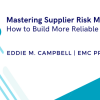Act Now to Address Inflation in 2022
Inflation is our call to arms.
Born from supply chain disruptions and shortages of commodities, renewed demand, cyberattacks and natural disasters, the annual producer price inflation for final manufactured goods jumped a whopping 7.8% in September 2021, up from 7.2% in August. With U.S. inflation hitting a 30-year high, there is no clear end in sight.
While computer chips, lumber (doubling in early 2021), steel (150% in early 2021), and automobiles (30% YoY) are making headlines, non-consumer services and goods, like shipping (10x YoY), oil and rare earth metals, are putting the squeeze on global enterprises.
So, how do we flip the script and act now to protect our company’s margins and continuity of supply?
Lock in Pricing
Lock in pricing for the next three years to avoid additional future damage to product margins, beginning with the products hardest hit by inflation and demand, such as raw materials and computer components. Several industries, led by industrial manufacturing, capital equipment and high tech, will continue seeing shortages for the foreseeable future. For instance, Micron, the leading memory-chip company, accelerated certain component purchases specifically to take advantage of pricing opportunities in the marketplace. Some food supply chains, such as Associated Wholesale Grocers Inc., are stockpiling certain products to ensure they’re able to keep customers happy.
Negotiate Up-Front Discounts and Incentives
Nearly all suppliers expect to be able to raise prices for 2022. While all companies need to be careful about how hard they negotiate with strategic partners right now, you can also use the incentive of more business by consolidating volumes to negotiate favorable prices because it’s a seller’s market. Ask for discounts for preordering, paying early or buying bulk. In industries such as managed service or software implementation deals, where rebates and future discounts are commonplace, push for that value to be realized and shown upfront through a sign-on or incentive bonus. This will maximize the benefit of those discounts by protecting against continued inflation. Include claw-back clauses in contracts to suppliers that are worried about risk from not meeting expected order volumes.
Plan for Budget Cuts to Production and Drive Efficiency
As costs continue to rise, finance will look to operations to make cuts to protect margins. Typically, companies look to cutting staff or capital spending first, but this tends to lead to other more complex problems in the future, such as higher turnover and reduced ability to react quickly to changes in demand or the broader market. Instead, evaluate your production and internal processes to identify cost reductions and efficiency. Follow the example of many fast-growing companies that are relentless about removing waste — redundant processes, out-of-date software and manual work — and be leaner.
Inflation is here for the foreseeable future. Act now to address the increasing cost of goods and supplies to remain competitive in your market. Be creative with contracts by opting for upfront value. Lock in pricing now, work collaboratively with your suppliers to keep pricing steady and look critically at ways to reduce process waste across your organization.









